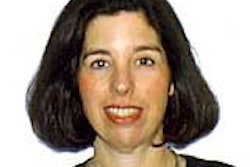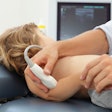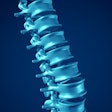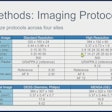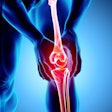
The enormity of the task ahead isn't lost on anyone working the 2002 Olympic Winter Games, least of all Dr. Julia Crim. She serves as chief of musculoskeletal radiology at the Olympic Polyclinic, where athletes and their families are being treated during the Games. Yet compared to her normal workday, Crim predicts that her 17-day Olympics stint will be as smooth as the driven snow.
"It’s not going to be as high-volume as my typical day, reading out skiers in the bone room here (at the University of Utah)," Crim told AuntMinnie.com. "We’re told that we’ll probably have about 20 visits a day, which is not a high volume. And it’s probably going to be clustered around events."
Still, what the Games lack in patient quantity, they’ll certainly make up for in quality. Crim and her staff will be treating some of the world’s top athletes during their time in Salt Lake City. In addition, she and the imaging staff will be working with some of the best radiology equipment out there. Finally, Crim has assembled a team of bone radiologists from around the country to staff the imaging section.
Crim, an associate professor and chief of musculoskeletal radiology at the University of Utah, took time out of her busy schedule to talk to AuntMinnie.com.
How did you become the chief of musculoskeletal radiology at the Polyclinic, and what intrigued you most about this job?
The University of Utah was selected by the Olympics to provide the medical care. Given that much of the imaging is musculoskeletal, I was the natural person to do it.
It’s a wonderful chance for us to evaluate injuries occurring in high-level athletes. We will actually have tapes of any injuries happening that we can then correlate with the MR findings, the CT findings, the ultrasound findings.
It’s also a nice chance for us because we’ve been given very high-end ultrasound equipment so that we can evaluate both ultrasound and MR (findings) in these high-level athletes.
Why ultrasound in particular?
One of the goals that I’ve had throughout my career is to try to promote musculoskeletal ultrasound, and I think this is a nice chance where we’ll be able to use it.
(Ultrasound) is something that tends to be underutilized in America, much more widely utilized in the rest of the world. MRI is more popular here, but it tends to be more expensive and harder on the patient.
Why do you think MRI is more popular in the U.S. for bone and joint imaging?
I think it is partly an issue of how radiologists are trained. Musculoskeletal radiologists in the U.S. traditionally do not train in ultrasound. (The Mallinckrodt Institute) in St. Louis is one of several exceptions, and we are very fortunate to have Dr. Bill Middleton from Mallinckrodt joining us (at the Polyclinic).
I was not taught musculoskeletal ultrasound in my residency or fellowship, but learned it from an excellent, self-taught ultrasonographer in private practice. He taught himself the method in response to demand by the orthopedic surgeons. The technique of musculoskeletal ultrasound does require a high level of operator expertise.
Also, I think that the ready availability of MRI in the U.S. has lessened the need to employ other modalities. However, as cost constraints increase, the value of less expensive modalities becomes more apparent. Musculoskeletal ultrasound has been shown to have equal reliability in the detection of rotator cuff tears, for example, to MRI.
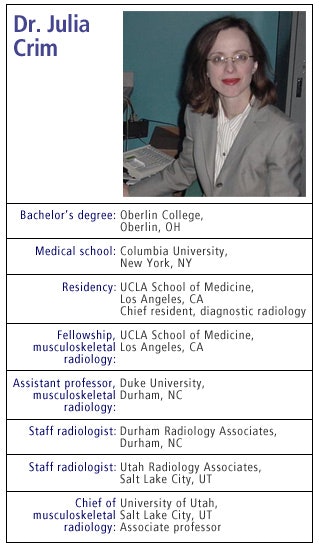 |
What kinds of injuries are you expecting to see during the Games?
You certainly have a lot of ligament tears around the knee. Snowboarders have a high prevalence of ankle injuries. We’re expecting to see our share of shoulder dislocations. Unfortunately, we’ll also probably be seeing some head trauma.
The major traumas are actually not coming here. They’re going to be going over to Latter Day Saints Hospital (LDS) in Salt Lake City. We’re going to be seeing more of the walk-in athletes who have the injuries on the slopes and don’t have to be airlifted out.
Can you tell us a little bit about the Polyclinic set-up?
It’s actually a very sweet set-up. It’s been put together both to maximize good patient flow and confidentiality.
The equipment has been provided with an eye to having very up-to-date, state-of-the-art equipment. So our MR is a 1.5 tesla (Signa Horizon MR/i, GE Medical Systems, Waukesha, WI) with all the current coils. The ultrasound is a very good HDI 5000 SonoCT upgrade, Philips Ultrasound, Bothell, WA).
We’re using Kodak DirectView DR 9000 (digital radiography), which I am also pleased with.
We’re going to be doing all of our reports on a Talk Technology workstation (equipped with TalkStationRadiology). We’re a filmless site. We’re going to be putting paper print-outs of the scans together with reports, and giving those to each athlete as they leave so that they’ll have a record to take back to their home country. It might be the first filmless Olympics.
And what about Polyclinic volunteer staffing?
Obviously, we’ve had a tremendous number of people who have wanted to volunteer. That’s been very exciting. In the radiology field, we’ve gathered some of the top academic bone radiologists that are going to be here. We’re very pleased with that. Each of them will work seven shifts. We have it set so that we’ll have our radiologists from around the country (at the Polyclinic) at various times, and I’m going to be there part of every day too, just to make sure things are running smoothly.
My top residents are going to be going over there as assistants. I think that’s going to be a very nice experience for them.
Obviously, these athletes are under a tremendous amount of pressure, not only from themselves, but also from trainers, agents, families, and the public. How do you address that kind of scrutiny when you are treating an injured athlete?
I’ve actually done sports medicine for professional team players, and that’s the same sort of pressure. It’s monetary pressure, they want the patient back (on his feet). And to tell you the truth, it doesn’t bother me. What I see is what I see. I approach the case the same way I approach any other case. It’s really a non-issue. If you are a radiologist, people are always coming down on you from one direction or another. It doesn’t really matter, you just go ahead and do your job.
Any idea as to what a typical day will be like for you at the Polyclinic?
I really have no idea, so I’m trying to remain flexible. I love to do musculoskeletal radiology. It’s just another opportunity to do that with people from around the world. And we’re all really hoping that people are going to see beyond the strange stories that have been in the press about Salt Lake City and just realize that this is a great place. We’re trying our best to make it a great experience for the athletes and their families.
I think it’s going to be tremendously good. We’re having all these top-flight people coming in. We’re going to have every facility that we would want. We’re going to be providing a service that people will be very pleased with. I’m just looking forward to it tremendously.
By Shalmali PalAuntMinnie.com staff writer
February 9, 2002
Related Reading
Bone and joint radiologists jump at Olympics chance, February 9, 2002
3-D shoulder ultrasound flexes its muscle, June 4, 2001
Ultrasound, MRI come up short in achilles tendon injuries, January 12, 2001
Ultrasound wins the gold at Sydney, November 8, 2000
Copyright © 2002 AuntMinnie.com






